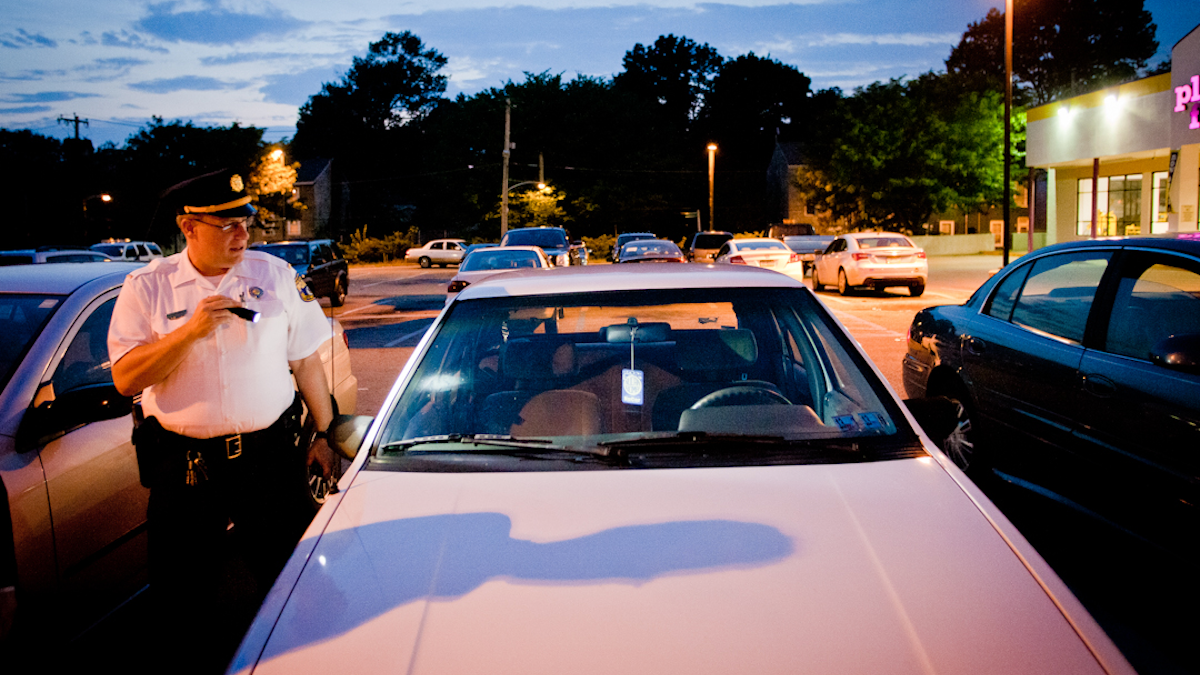A guide to preventing car break-ins in Northwest Philadelphia [video]

About reporting car break-ins, 14th District Police Lt. Dennis Rosenbaum says "Some people think they are bothering us, but that's what we get paid to do."(Brad Larrison/for NewsWorks)
The parking lot at the Valley Green Inn is an idyllic starting point for the many joggers, hikers and bicyclists who come from across the region to luxuriate in the natural beauty of the Wissahickon Valley Park.
The lot is also an ideal setting for thieves who descend upon Valley Green because joggers, hikers, and bicyclists often leave valuables in their cars while they’re off luxuriating in that natural beauty.
On a recent weekday evening, a police lieutenant, cameraman and reporter were examining a sedan parked in the lot, trying to determine whether the sunglasses left on the seat were expensive Ray-Bans or less-costly knocks-offs.
While doing so, a woman approached and asked the trio if they were trying to break into the car.
“That’s what we’re trying to prevent!” replied Lt. Dennis Rosenbaum.
Common crimes, easy prevention
Ask any supervisor in the 14th Police District about the most persistent property crime in their sectors since summer began, and they’re apt to offer three words: “Theft from auto.”
Translated, it means that thieves are habitually breaking into cars through the approximately 12 square miles of a district which stretches from Southwest Germantown to Chestnut Hill.
It tends to occur away from major thoroughfares, with residents being targeted in their own neighborhoods, on side streets and, sometimes, in their own driveways.
However, theft-from-auto’s dirty little secret is this: Thieves don’t break into cars randomly; they’re looking for a score that can be quickly turned into cash.
If you look at police reports, though, some residents are unfortunately making it easy for them, leaving electronics, wallets, purses and other valuables in plain sight in sometimes-unlocked cars.
In order to get a better glimpse at the problem, NewsWorks recently set out with a supervisor from the 14th District to perform a “windshield survey” to see for ourselves what people in some of the hardest hit areas for theft from auto are leaving in their cars.
Tour de Thefts
Starting off at Valley Green, the results were immediate, as all sorts of tempting objects were left in plain sight.
Purses. Briefcases. Clothing. Loose change. Compact-disc folders. A seed spreader. A “Home Alone” DVD. Obviously-full gym bags. In addition to all that, GPS cradles and a plethora of charger cables for electronics equipment were visible, suggesting further surprises within.
The worst culprit that evening was a Mercedes sedan with New Jersey plates in which a personal check was left on the front seat, a change purse in the cup holder, a $50 bill tucked away in the center console and an iPhone left charging in dashboard.
As for keeping windows open just a crack just to keep the car cool?
“I wouldn’t recommend it,” Rosenbaum said. “You’re giving thieves an option. All they have to do if they want something is to yank that window right down, which breaks the crank system inside. The window falls right down into the door.”
“Cars these days have sophisticated air conditioning and ventilation systems,” he continued. “It just takes a second.”
Trends and locations
Rosenbaum, an 18-year PPD veteran, has spent much of the last year combating 14th District property crimes.
Viewing a computerized breakdown of trends, Rosenbaum ticked off some of the significant spots for thefts within the district:
Wayne Avenue.
Chelten Avenue.
Chew Avenue.
East Mt. Airy Avenue.
“They all hover off the main drags,” he observed.
While Valley Green is typically a daytime target, theft from auto usually takes places in the overnight hours in the neighborhoods themselves.
Police reports will often indicate 7 or 8 a.m., but that is when the victim files a report, not when the crime occurred.
Entry is decidedly low-tech: Generally, a rock is used to break the glass or, on occasion, an emergency auto-glass safety hammer. Sometimes, thieves physically bend and pull open the door.
Rosenbaum noted that Slim Jims have fallen out favor among the criminal set, but an increasingly important accessory has become a $1 LED flashlight that allows thieves to peer through tinted windows.
“We see that a lot when we arrest them,” said Rosenbaum, noting that the light’s small size doesn’t draw attention yet fits into one’s mouth for quick searches.
It tends to be a young-man’s crime, with Rosenbaum saying most suspects tend to be males between the ages of 16 and 24. The balance of crimes is attributable to homeless persons of varying age.
Electronic item taken can be sold on the street; phones, laptops and GPS systems can end up in pawn shops or refurbishers. EZ-Pass transmitters, while ubiquitous, have not developed much street value as they are easily traceable.
The bottom line, said Rosenbaum: “Just because you have tint doesn’t mean anything.”
Crunching the numbers
Despite the widespread occurrence of the thefts, there is a slight downward trend citywide.
The day-to-day, week-to-week stats fluctuate but, overall, the city is experiencing several hundred fewer thefts from vehicles so far this year, down from 7,842 to 7,367 as of Sept. 1.
The 14th District has seen 359 incidents from Jan. 1 through Sept. 11, a 26-percent reduction from the 480 thefts in during the same period in 2012.
While this amounts to about 30 thefts a day, the unfortunate reality of statistics — especially for property crimes like theft from auto — is underreporting.
In response to this, Rosenbaum said residents should never hesitate to notify police, as the department needs this data to fight crime effectively.
“Once we know it’s reported, we can see it and pick up on patterns,” said Rosenbaum. “If it’s not being reported, we’re not seeing the pattern and we can’t deploy accordingly to fix the problem.”
With that information, officers can be deployed to problem areas, including plainclothes cops and unmarked vehicles. In the 14th District, dedicated manpower responds solely to suspicious-person and theft-from-auto calls.
Rosenbaum said the 14th District currently averages one or two arrests per week. The number of overall theft-from-auto cases was not available as of press time.
Depending on the dollar amount, suspects face either misdemeanor or felony charges. While most of the crimes are classified as low-end offenses, Rosenbaum insisted that police want to know about every crime.
“Some people think they are bothering us,” he said, “but that’s what we get paid to do.”
End of the tour
Car break-ins are also a problem for the neighboring 5th Police District.
While they’re getting some assistance from neighborhood groups, Community Relations Officer Charles Kline said that they have been paying close attention to the area around Valley Green Inn.
Recently, while flyering cars to alert them to the theft problem in the Wissahickon, Kline himself saw several purses sitting in the plain view of vehicles.
He warned visitors against placing valuables in their trunks while in the lot, as thieves are believed to observe cars from vantage points overlooking the lot.
Despite the efforts of police to get the word out, there may be a culture of acceptance surrounding these seemingly insignificant property crimes, though.
“Most people would put up with quality-of-life problems than barrages of gunfire every day,” Rosenbaum said.
WHYY is your source for fact-based, in-depth journalism and information. As a nonprofit organization, we rely on financial support from readers like you. Please give today.




